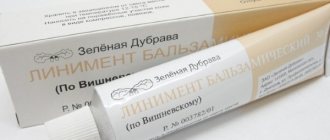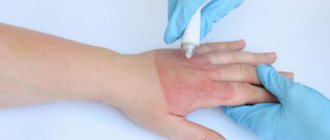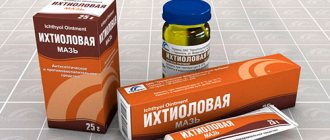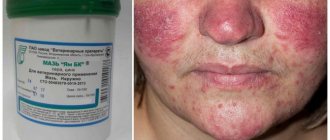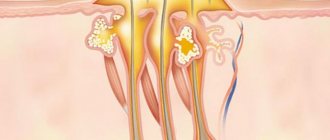"Levomekol" is an antibacterial combination drug for external use with a wide spectrum of action. Levomekol ointment prevents the spread of pathogenic microbes, eliminates swelling, accelerates wound healing, and also increases local skin immunity.
Levomekol for burns
This combination is provided by two active components in the ointment - Chloramphenicol (aka Levomycetin) and Methyluracil. Chloramphenicol is a natural antibiotic that actively blocks intestinal, pseudomonas and staphylococcal bacilli. And methyluracil accelerates the regeneration of the epidermis. The peculiarity of methyluracil is its ability to easily and quickly penetrate into the dermis, without affecting the membrane cell membrane. This process is associated with the removal of excess fluid from the intercellular space, which usually causes swelling and bruising.
What is Levomekol used for?
Levomekol has a multifaceted therapeutic effect:
- quickly reduces the inflammatory process, prevents its spread to healthy tissues;
- prevents the growth and reproduction of bacterial infectious agents;
- quickly eliminates swelling by normalizing microcirculation;
- ensures delivery of nutrients and biologically active substances, as well as molecular oxygen, to the affected tissues;
- stimulates the regeneration of inflammatory cells of all layers of the epidermis;
- increases immunity at the local level.
The ointment quickly removes all inflammatory processes on the skin
It is worth noting that the presence of purulent discharge and necrotic tissue does not prevent Levomekol ointment from performing its function. The drug can be used to disinfect and accelerate tissue regeneration.
Levomekol, ointment for external use, 40 g, 1 pc.
STADA, Russia
Price from 126₽
There are contraindications. Specialist consultation is required.
How does Vishnevsky Ointment work?
So, we have analyzed the composition and properties of the individual components of the product. Now let's take a closer look at the principles of its operation.
There is purulent inflammation, in which the sebaceous gland becomes infected with microbes. After infection, inflammation develops, aimed at limiting the infected area from healthy tissues due to swelling of surrounding tissues. At the same time, the blood supply in this area is disrupted and the permeability of the capillaries increases, so part of the plasma enters the lumen of this cavity (exudation occurs) so that immune cells (macrophages, leukocytes and others) enter the area of infection and begin to fight microbes. Thus, pus is formed - a mixture of exudate, living and dead microbes and their waste products, and dead immune cells.
Pimple in section
The pore-cleansing effect of Vishnevsky’s ointment is based on the law of osmosis, according to which the solvent (water) moves through a semi-permeable membrane (skin) towards a higher concentration of substances.
Since Vishnevsky ointment, when applied to the skin, creates an excessive concentration of water-attracting phenolic compounds and terpenoids, the movement of plasma, exudate and liquid purulent contents tends to the surface of the skin.
What is osmosis? We explained it in the picture
Do not be afraid of dehydration in the area where the product acts.
For two reasons:
- The irritating effect of the drug promotes blood flow to the area, that is, improvement of trophism. Given that some of the fluid from the tissues is directed osmotically upward to the surface of the skin, a constant flow of blood helps to better cleanse the area of pus. There is also “replenishment” of water in this area.
- Our skin is not even in a damaged state, so it constantly loses water. This is a natural process that helps cleanse the skin of toxins, microbes and waste products, and it is called trans-epidermal water loss (TEWL).
Transepithelial water loss
On the other hand, a powerful antiseptic effect prevents the development of microbes and promotes asepsis of the wound. A wound devoid of germs heals much faster. But that's not all. Thanks to birch tar, a fairly strong healing effect is realized. In some cases, you will see new tissue forming in just one or two days before your eyes.
Indications for use of Levomekol ointment
Since Levomekol ointment has an antibacterial effect, and at the same time stimulates the restoration of tissue structure, the drug is indicated for the following diseases:
- infection of wounds with pathogenic microflora, ulcers and purulent abscesses on the epidermis;
- burns (mostly 2nd and 3rd degree);
- violation of tissue integrity due to injuries;
- necrotic processes;
- weeping and dry eczema;
- calluses;
- trophic ulcers;
- frostbite of the extremities (superficial layers of the skin);
- pimples, acne, carbuncles, boils;
- otitis and sinusitis (including with purulent discharge);
- treatment of sutures after surgery
- bedsores;
- haemorrhoids.
Levomekol ointment can be used for children
"Levomekol" can be used for children from 1 year. But before this, it is imperative to consult a pediatrician.
What is the difference between Vishnevsky ointment and Levomekol ointment?
Levomekol ointment contains the immunostimulant Methyluracil and the antibiotic Levomycetin. The ointment is prescribed for the treatment of trophic ulcers, burns and purulent wounds, as well as other dermatological diseases of an infectious nature.
Levomekol has a more pronounced effect than Vishnevsky ointment. Another advantage of Levomekol ointment is that it does not have such a pronounced unpleasant odor.
The doctor must determine which ointment to use to treat a specific disease, based on the severity of the skin infection and the general condition of the patient. If a quick effect is needed, then Levomekol with an antibacterial component should be prescribed. With slight suppuration, preference should be given to Vishnevsky ointment.
The antibiotic included in the ointment Levomekol is able to penetrate the blood and have a systemic effect on the body. Therefore, this drug is not recommended for use by women carrying a child.
Vishnevsky ointment is an inexpensive and effective remedy for the rapid treatment of boils and purulent abscesses. To minimize the risk of growth of anaerobic bacteria, it is necessary to thoroughly clean the surface of the skin before applying the ointment.
Contraindications
Like many drugs, Levomekol has contraindications:
- individual intolerance to the components of the medication;
- hypersensitivity of the body;
- fungal infections of the epidermis;
- tendency to allergic reactions;
- psoriasis.
The official instructions for use indicate that in pediatrics the ointment is prescribed starting from 3 years of age. However, many pediatricians, based on the harmlessness of Levomekol, allow its use from infancy.
All the pros and cons
Studying the annotation for liniment, one can only wonder how just three natural components included in its composition can produce such an amazing pharmacological effect. It is believed that the drug is able to cope with almost any skin problem, and this versatility is easily explained by the natural properties of its ingredients.
The register of positive properties provided by the ointment includes 7 main points:
- Stops inflammatory processes.
- Disinfects affected areas.
- Stimulates skin receptors.
- Triggers cell regeneration.
- Acts as an antiseptic.
- Dries out the skin.
- Relieves swelling of external tissues.
Among the advantages, it is also worth noting the low price, availability at any pharmacy without a prescription, and long shelf life. Although Vishnevsky's ointment belongs to the old generation of drugs, attending physicians in medical institutions willingly prescribe it as a safe disinfectant and restorative external agent.
A minor disadvantage is that with prolonged use, liniment can cause dry skin, itching, peeling, and rashes. In addition, the tar included in the composition develops sensitivity to ultraviolet radiation, therefore, during the course of treatment, prolonged exposure to the sun should be avoided. The main disadvantage of the ointment was and remains its strong unpleasant odor, which in rare cases of individual intolerance can cause allergic reactions.
Side effects
Levomekol is considered a universal drug and is usually well tolerated by patients. But in case of overdose (if the drug is used for more than a week), allergic skin reactions may occur.
- hyperemia;
- burning;
- itching;
- urticaria;
- dermatitis at the site of application;
- local swelling;
- When using vaginal tampons, candidiasis may occur.
No incompatibility with other medicinal products has been reported. Make sure that the ointment does not get into your eyes, mucous membranes or inside. In case of contact with eyes and mucous membranes, rinse them immediately with running water. If swallowed, the stomach must be rinsed.
Composition and medicinal properties of the ointment
Balsamic liniment has birch tar as its main active ingredient.
Vishnevsky's ointment contains only 3 components, each of which enhances the effect of each other.
- Purified birch tar. This component is natural. It is obtained from birch bark. Tar looks like a thick, dark, viscous liquid. This is the strongest natural antiseptic that is effective against most pathogenic bacteria that can cause inflammation in humans. Additionally, the component actively enhances blood circulation at the site of application and increases the ability of tissues to regenerate. The property of tar to eliminate pain, burning and itching is also valuable. Its use is also possible on wet wounds, since the substance helps dry them. For burns, wounds, bruises and wen, tar has been used for a long time.
- Castor oil (a number of manufacturers replace it with fish oil, but this is not a desirable option). The component in the ointment enhances its ability to quickly penetrate tissue. Additionally, the substance in combination with tar also acts as a strong sedative for the affected skin, relieving pain and itching.
- Xeroform. Promotes drying of the wound surface and enhances the antiseptic effect of the drug.
The ratio of active ingredients in the drug is as follows:
- 94% castor oil,
- 3% tar,
- 3% xeroform.
The smell of the ointment is specific and very pungent, which is provided mainly by tar. Even under a bandage, it is clearly noticeable to others. The color of the drug, depending on the manufacturer, is brown or dark dirty yellow.
The drug is produced in the form of liniment, which is thinner than ointment and penetrates tissue more easily.
The main medicinal properties of Vishnevsky’s ointment (liniment) are as follows:
- local immunomodulatory;
- pulling (cleansing);
- antiseptic;
- bactericidal;
- healing;
- pain reliever;
- antipruritic.
In some cases, it is recommended to mix the medicine with Shostakovsky balm (vinilin). The drugs enhance each other’s actions and have an even more active effect on the body.
The ability of the drug to stimulate the regeneration of the skin and deeper tissues allows it to be used to treat third-degree burns, which in this case, after healing, do not leave strong scars, which is of great importance for tissue damage in open areas of the body.
In addition to skin lesions and injuries, the ointment is also used for internal inflammation of the genitourinary system and mammary glands.
The drug is prescribed in the following areas of medicine:
- gynecology;
- dermatology;
- traumatology;
- surgery;
- urology;
- proctology;
- dermatology;
- cosmetology.
The product is available over-the-counter because it is not an antibiotic or hormonal drug.
Levomekol in the treatment of burns
For burns, Levomekol is needed to prevent infection of the wound surface with pathogenic infections, as well as to accelerate tissue healing. Levomekol also copes with inflammation, which can lead to suppuration of the wound. The ointment cleanses the affected area well from both purulent discharge and necrotic cells.
The treatment system for a small area burn of 1-2 degrees is as follows:
- before applying the ointment, the wound is washed under running water;
- the ointment is applied to a sterile gauze pad, which is applied to the wound surface;
- the bandage is applied for a day;
- dressings are done every day - up to 5 times a day.
The burn is treated until the tissue is completely healed. The total duration of the course for minor household burns is 5 – 14 days.
Levomekol in the treatment of acne
"Levomekol" has an antibacterial and wound-healing effect, therefore it is widely used in dermatology, in particular, in the treatment of acne. The course of treatment depends on the severity of the disease and the number of skin rashes.
Small pimples are treated by applying a thin layer of ointment to the affected area. This is done in the evening for several hours, and before bedtime Levomekol is washed off. Within two weeks, pimples disappear, facial skin becomes even, and small scars heal.
Treating acne with ointment
Levomekol is applied to isolated inflamed pimples in a thin layer, covered with a small piece of cotton wool and left for 2-3 hours. Therapy lasts 2-3 days.
As for opened pimples, the medicine is placed directly into the resulting holes.
To treat acne, Levomekol is applied to the affected area overnight. In the morning, the ointment must be washed off. Typically, the course of treatment takes 2 weeks, during which the inflammation subsides and the acne breaks out or resolves.
To eliminate subcutaneous acne, you need to do the following:
- after washing with soap, the skin is cleansed with any tonic or lotion;
- Apply the ointment in a thin layer on a sterile napkin and apply it to the area of skin with acne;
- the bandage is fixed with adhesive tape.
The duration of the treatment procedure is 3-5 hours. If deep, painful ulcers appear on the skin, keep the bandage on the body all night.
The duration of therapy is about 7-10 days, depending on the degree of damage to the dermis.
Reviews
Irina, 31 years old:
From time to time, single pimples appear on the body. Since adolescence, my grandmother advised me to apply Vishnevsky ointment. I did this with an adhesive plaster. In each case, it was possible to quickly get rid of the inflamed spots. When studying the instructions, I was pleasantly surprised by the wide spectrum of action of the composition, which the drug and the simple method of use help with.
At the moment, to solve such problems I use liniment and Levomekol ointment. The effectiveness and pricing policy of both drugs are the main advantages of the drugs.
Sergey, 40 years old:
A couple of years ago I had to see a doctor with an abscess in the armpit. On the advice of a specialist, I applied compresses from Vishnevsky’s ointment to the causative area for 3 days. On the fourth day, the abscess opened. Thanks to an affordable and effective drug, I experienced great relief. The only drawback of the product is the smell of the composition, but this is not a priority in treatment.
Maria, 27 years old:
A few months ago I was in a gynecology hospital with severe inflammation. After discharge, the doctor advised to use tampons with Vishnevsky ointment for 5 days to consolidate the effect. This remedy was part of a comprehensive treatment in the hospital, but only at home I felt an incredibly unpleasant aroma. I made an appointment with the doctor to replace the drug with some analogue. At the appointment, the specialist spoke briefly about the healing qualities of the ointment, after which I changed my mind about liniment. This unique composition, which has not lost its popularity among a large number of new products, really saves people's lives.
Levomekol in the treatment of hemorrhoids
Levomekol ointment can be used as an addition to complex therapy for hemorrhoids during periods of exacerbation. It is recommended to use the ointment in cases where blood is released from the hemorrhoids. Since the drug has an antibacterial effect (wounds can be infected with feces), helps relieve inflammation and neutralize pathogenic bacteria, Levomekol is prescribed for the regeneration of anal tissue.
- it is necessary to wash the perineum and anus with soap and water and dry with a soft towel;
- apply a thin layer of ointment to the anus before going to bed;
- the area of influence from above is covered with a bandage and fixed with an adhesive plaster;
- When treating internal nodes, a tampon is soaked in ointment, which is then inserted into the anus.
Levomekol for hemorrhoids
The duration of therapy is 10 days. Since Levomekol is not a specialized antihemorrhoidal drug, after the inflammation has resolved, the decision to continue therapy and prescribe medications is made only by the attending physician.
Levomekol in the treatment of wounds
Levomekol helps heal damaged tissue and prevents infection of the wound surface. Moreover, it is not so important whether the wound has festered or not. If the wound is not purulent, then first the affected area is treated with an antiseptic. The ointment is applied in a thin layer overnight, then it must be covered with a sterile gauze cloth and secured with a bandage. Most often, wound treatment is required once a day.
If the wound festers, then using cotton-gauze swabs moistened with an antiseptic, the pus and secreted secretions are removed. Then Levomekol ointment is applied to the wound - it should be completely filled, but not too tightly. The affected area is covered with a gauze cloth, also soaked in ointment. As for the frequency of changing the bandage, it all depends on the amount of pus released. Usually a double dressing is sufficient.
And if the wound is deep and accompanied by an infectious lesion, then Levomekol is preheated to 35 degrees Celsius, then a sterile napkin is soaked in ointment (several can be used if the affected area is large) and injected into the lesion. If the affected area is large, use several napkins with Levomekol. It is important that the wound is filled completely, but not too tightly.
Note that to administer the medication into puncture and deep wounds, it is better to use a rubber drainage tube, and inject the heated ointment itself using a syringe.
The duration of therapy usually lasts from 5 to 10 days.
Use of Levomekol ointment in gynecology
Levomekol is successfully used in gynecology and urology.
In gynecology, therapy is carried out using tampons with ointment applied to them. A similar method is indicated for the treatment of the following conditions:
- inflammatory erosion of the cervix;
- inflammation of the uterine appendages (ovaries, fallopian tubes);
- divergence of vaginal sutures after ruptures during childbirth or operations.
The treatment system consists of the following sequence of actions:
- before use, a woman must thoroughly wash and dry the skin of the treatment area and perineum;
- if therapy is used after the divergence of vaginal sutures or after operations, then the sutures must be treated with a weak solution of potassium permanganate or furatsilin;
- you need to make a small cotton swab, put an ointment on top of it measuring 15 mm x 15 mm, and 5 mm high;
- insert into the vagina at night and remove in the morning;
- if therapy is used after the divergence of vaginal sutures or after operations, then the ointment is applied to a gauze bandage and applied to the sutures. Then put on clean underwear (if necessary, you can additionally use a pad). The dressing remains on for 2 to 6 hours.
Using the method described above, the active substance of the ointment is delivered to the affected area and absorbed into the surrounding vaginal tissue.
In urology, Levomekol is used in the treatment of balanitis and balanoposthitis in men, as it has anti-inflammatory and antimicrobial effects. The treatment system consists of the following sequence of actions:
- before applying the ointment, the head of the penis is washed with a weak solution of potassium permanganate or furatsilin, removing pus and dead tissue;
- Levomekol is applied to the affected area in a dense layer.
The remedy is applied 1-2 times a day until complete recovery. After the inflammation is relieved, Levomekol is applied for another week, 1 time per day - in the evening, before bedtime.
Vishnevsky ointment for infertility
As you know, Vishnevsky ointment is the best remedy for “pulling out” pus from various wounds. Thanks to this, it can even be used in the treatment of infertility caused by chronic endometritis (a chronic inflammatory process in the surface layer of the endometrium, the inner mucous membrane of the uterine body).
Treatment of this type of female infertility begins with an operation to clean the fallopian tubes, then tampons with Vishnevsky ointment are prescribed to speed up healing. Starting from the second day, a tampon with twenty milliliters of ointment is inserted into the vagina. Tampons are placed at night every other day. In the morning, a woman is advised to douche with an infusion of chamomile.
Other methods of treating this type of infertility show only 25% of cases of successful treatment and restoration of fertility function, while procedures with Vishnevsky ointment increase this figure to 56%.
Levomekol or Vishnevsky ointment. What's better?
Let's start with the fact that Vishnevsky ointment and Levomekol, although they are used in similar cases, still have a multidirectional spectrum of action. Thus, Vishnevsky ointment is effective when the wound is in the process of regeneration. Therefore, it cannot be used when the wound is suppurated or severely inflamed. Yes, the drug contains an antiseptic, but its concentration is not enough to provide a bactericidal effect. Moreover, tar and castor oil stimulate blood circulation in the affected area, which worsens the situation.
This is why Vishnevsky’s ointment is not as effective, since Levomekol has higher antibacterial activity due to the presence of an antibiotic in it and accelerates the process of outflow of pus from the wound. Also important are the following distinctive features that determine the superiority of Levomekol ointment:
- no unpleasant odor;
- higher repair characteristics;
- does not provoke irritation in the treatment area;
- when treating boils, Levomekol quickly initiates an abscess and opening of the abscess, followed by wound healing.
But if Vishnevsky ointment helps the patient, then there is little point in changing it.
Methods of using Vishnevsky ointment
The main ways to use the ointment are:
- compress,
- bandage,
- tampon,
- external application.
External application is the most common method of using Vishnevsky ointment; its essence is to spread the drug on the affected area of the skin. But before that, do not forget about sanitizing the wound or area of affected skin.
The second method (bandages with Vishnevsky ointment) involves the use of gauze folded in several layers, onto which the ointment is applied and covered to the wound, secured with a bandage. The dressing is changed daily.
The compress is practically no different from the bandage except for the time of use, usually from two to twelve hours.
Tampons are used for internal application of ointment in cases of hemorrhoids or inflammatory processes in the uterus.
Analogs
Analogs of Levomekol ointment have a bactericidal and healing effect. But the difference lies in the active ingredient of the drug. So, among the analogues one can name Fugentin, Levosin (additionally has an analgesic effect), Protegentin, Fastin-1, Salicylic-zinc paste.
Synonyms, that is, drugs with the same substance (but in higher concentration) as Levomekol ointment, can be considered Netran and Levomethyl. Substitute medications can only be prescribed by the attending physician.
What do the doctor's say
In modern medical circles there is no consensus on the effectiveness of the legendary ointment. Some experts believe that it was good for its time, but against the backdrop of recent advances in the field of pharmaceuticals it looks very poor. There are those who openly doubt the existence of a “miracle cure” for any ailment. Their slogan goes something like this: “For every disease there is a cure.” From the point of view of evidence-based medicine, which emerged at the end of the 20th century, liniment is classified as a drug with officially unconfirmed effectiveness, and, therefore, is recognized as an outdated dosage form.
However, even among attending physicians you can find many fans of Vishnevsky ointment. Having solid medical experience behind them and a lot of examples from patient histories, they still prescribe balsamic liniment as an effective time-tested antiseptic. The natural composition of the drug, transparent pharmacology and the absence of contraindications are the most powerful arguments in favor of the ointment.

